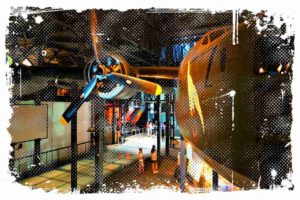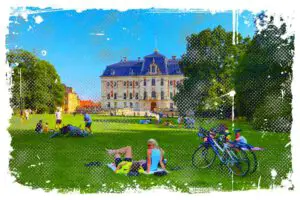Are you wondering where to spend a weekend in the south of Poland? I think this article will spark your curiosity to explore hidden gems in Poland and uncover a bit of history you haven’t encountered yet.
Poland, my beloved homeland, is vast, and I always find joy in discovering its new corners. As someone who embraces slow life and responsible travel, I prefer nature to big cities and deeply value our cultural heritage. I have put together some ideas for a weekend in southern Poland that, I hope, are new or perhaps underrated by you.
Lublin – Town
Lublin is a city that has been around for over 700 years. It all started in 1317, and the city experienced its best times during the Jagiellonian dynasty. Back then, it was on the trade route from Kraków to Vilnius. The Union of Lublin, signed in 1569, was the first real union in Poland’s history, creating the Polish-Lithuanian Commonwealth.

The Old Town, accessible through the Krakow Gate built by Casimir the Great, showcases various architectural styles and cultures. For years, Lublin was a place where Polish, Lithuanian, Jewish, Russian, and Armenian traditions mixed.
↳ PRO TIP: Do you like traveling? Then before you buy any ticket or book an attraction, check if it's available in this worldwide Viator Database. You may save a lot of money and time. No need to thank me :)
Casimir the Great also ordered the construction of a castle on a former stronghold site, which in recent times served as a prison.
Lublin is known for its onions and Perła beer. Plus, it is a youth and university city, with six universities for nearly 350,000 inhabitants.
Lublin Village Museum
The Lublin Village Museum is one of the biggest open-air museums in Poland, and it’s incredible! You can literally travel back in time to the countryside of Roztocze, Lublin Upland, Powiśle, Podlasie, and Nadbuże. There is a reconstructed town, a noble manor house, stables, fields, gardens, meadows, groves, orchards, and many animals.

Animals like hens, geese, ducks, goats, horses, and cows roam freely. In spring, you’ll see ducks leading their young.
Polesie National Park
Now, let’s go to Polesie, on the Łęczyńsko–Włodawa Plain. Polesie is a geographic and historical region in Ukraine, Belarus, and Poland. It is a plain in the Pripyat and Bug basin, home to marshes, peat bogs, karst lakes, and forests.

The crane is the symbol of Polesie National Park. In autumn, the meadows become a birdwatcher’s paradise, and in spring, the trees and swamps are filled with bird songs.
There are several nature paths with footbridges over swamps and peat bogs. In spring, the swamps are beautifully in bloom. On the lakes, gulls and terns take care of their young. You can also spot herons, storks, swans, and greylag geese.
Despite the annoying mosquitoes, you can find frogs and mud turtles in the peat bogs. Weekends can be busy, but weekdays are usually quiet and peaceful.
Czartoryski Palace and Park in Puławy
Puławy is the largest city on the Vistula River between Krakow and Warsaw. It is mainly associated with Grupa Azoty and Czartoryski.
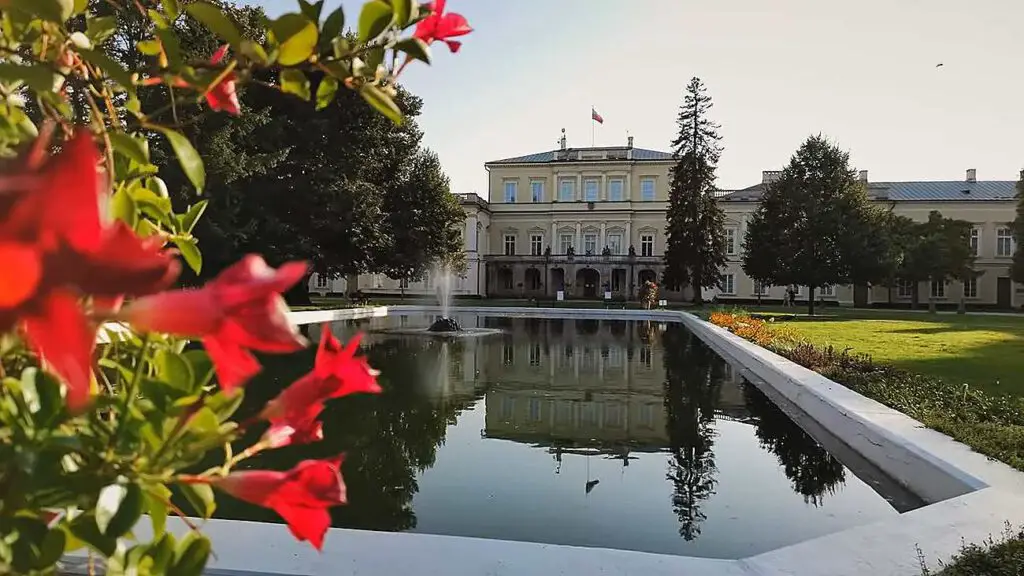
The first national museum in Poland was established in the Czartoryski Palace in Puławy. In the late 18th and early 19th centuries, Puławy was a key center for political, social, and cultural activities in Poland, earning it the nickname “Polish Athens”.
If you want to explore southern Poland, these are must-visit places. You will learn about history, nature, and culture.
Zamość – UNESO Town
Zamość, often called the Pearl of the Borderlands or the Pearl of the Renaissance, is a masterpiece of architecture. Other names for it include the City of Arkad and the Padua of the North. Each of these names captures the essence of the city’s architectural brilliance.

In 1580, Jan Zamoyski, a Hetman and the Great Crown Chancellor of the Republic of Poland, founded Zamość as a private noble town. He hired Italian master Bernardo Morando to design the ideal city.
The aim was to protect the Zamoyski family’s surrounding estates with the Zamość Fortress, which was then one of the largest in the Polish-Lithuanian Commonwealth. In 1589, it became the capital of the Zamoyski Estate, an indivisible property inherited by the oldest male descendant of the family.

Today, the Old Town of Zamość is small but stunning. At its heart is the Town Hall, accessible by fan-shaped stairs. Surrounding the Market Square are Mannerist-Baroque Armenian tenement houses with vibrant colrs like yellow, blue, red, dark yellow, and green.
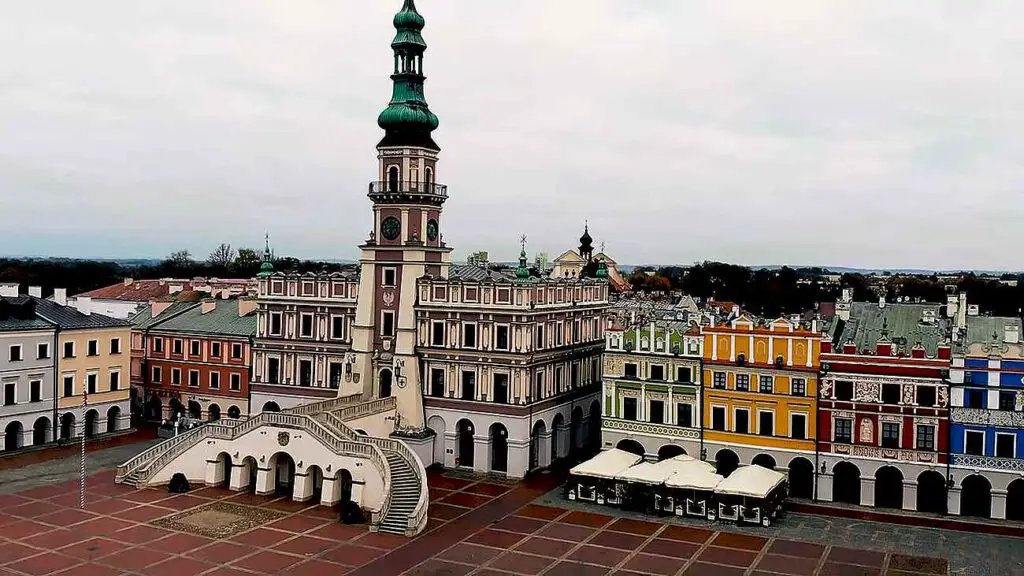
They are a sight to behold! The square is also home to ice cream parlors, stalls, and pubs where you can enjoy a tasty lunch or a regional beer under an umbrella.
In 1992, Zamość’s old town was recognized as a UNESCO World Heritage Site.
Roztocze – Region
Roztocze is a geographic region between Kraśnik and Lviv, characterized by forests, meadows, Polish Konik horses, and Uhruska sheep. The name, which means “a place where two streams diverge” refers to the hills that separate rivers flowing into the Baltic and Black Seas. It was first used in the 19th century by Galician geographers.

Roztocze is also called the “sun pole of Poland” because it is the sunniest region in the country, according to meteorological research.
Visiting Roztocze is an opportunity to enjoy quiet moments walking in the meadows, listening to the Tawia river, kayaking down the Wieprz River, and sipping wine in a vineyard.
Kozłówka – Town
Kozłówka is a small town in the Lublin Voivodeship, mostly known for the Zamoyski Palace. Built in the 18th century in Baroque style, the palace saw its heyday at the turn of the 19th and 20th centuries when Konstanty Zamoyski established the estate.

Today, the Zamoyski Palace in Kozłówka is a must-visit museum. You’ll be captivated by the beautiful rose garden and interiors filled with paintings, lamps, sculptures, furniture, curtains, and canopies from that era. It is a perfect blend of splendor and elegance.
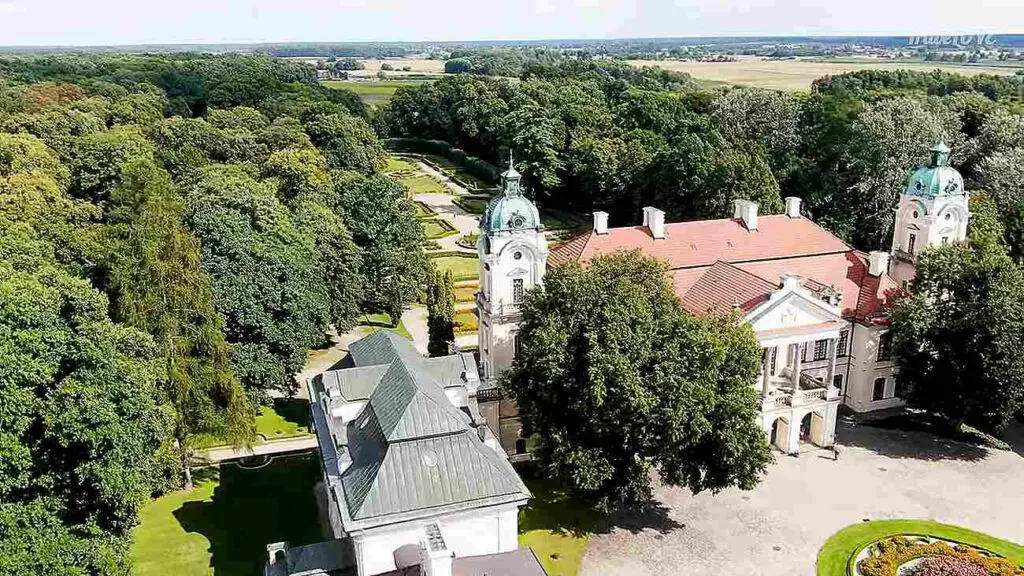
The former carriage house is now the Museum of Socialist Realism, displaying a collection of sculptures, paintings, drawings, posters, and monuments from the socialist realism era. Some pieces may seem raw, funny, or exaggerated from today’s perspective, but they are an essential part of history.
Kazimierz Dolny – Town
Kazimierz Dolny is a true gem among Polish cities and a haven for artists. Its history goes back to the Middle Ages when Kazimierz the Just, son of Bolesław Krzywousty, donated the land and surrounding areas to the Norbertine monastery.

In honor of him, the settlement was named Kazimierz. The development of the area was due to a trade route from Lviv, through Lublin, to Radom, where it crossed the Vistula river at its narrowest and safest point.
In the 14th century, Casimir the Great granted the settlement town rights and built a brick castle. Over the years, the city prospered from the grain trade, reaching its “Golden Age” from the mid-sixteenth to mid-seventeenth centuries. At its peak, there were 60 granaries, a massive Vistula port, and wealthy merchants built lavish tenement houses.
After World War I, students from the Warsaw School of Fine Arts visited for painting plein-airs, and in the following years, more artists followed. Today, Kazimierz Dolny is synonymous with painting, sculpture, art galleries, and artists painting outdoors.
Loess Gorges
Loess is a loose sedimentary rock that is relatively soft, making it prone to erosion, resulting in numerous ravines. Over time, water and wind have sculpted this malleable rock into incredible formations. The Kazimierz Landscape Park boasts the highest concentration of such ravines in Europe.

Korzeniowy Dół is one of the most beautiful ravines. Its high walls and a maze of massive tree roots protruding from them, forming a roof that shields us from the sky and sun, give it a fairy-tale-like beauty, making it the most famous and visited ravine.
Częstochowa – Jasna Góra Monastery
The Pauline Monastery at Jasna Góra is not only a special place of worship and a destination for annual pilgrimages but also a significant symbol in Polish history.

The defense of the monastery, led by Father Augustyn Kordecki during the Swedish Deluge, symbolizes Polish resistance and is synonymos with hard, arduous, but successful work in Polish culture.
In the chapel of Our Lady, the miraculous image of Our Lady of Częstochowa, also known as the Black Madonna, is kept. It is a 15th-century copy of the icon destroyed in 1430.
Będzin Castle
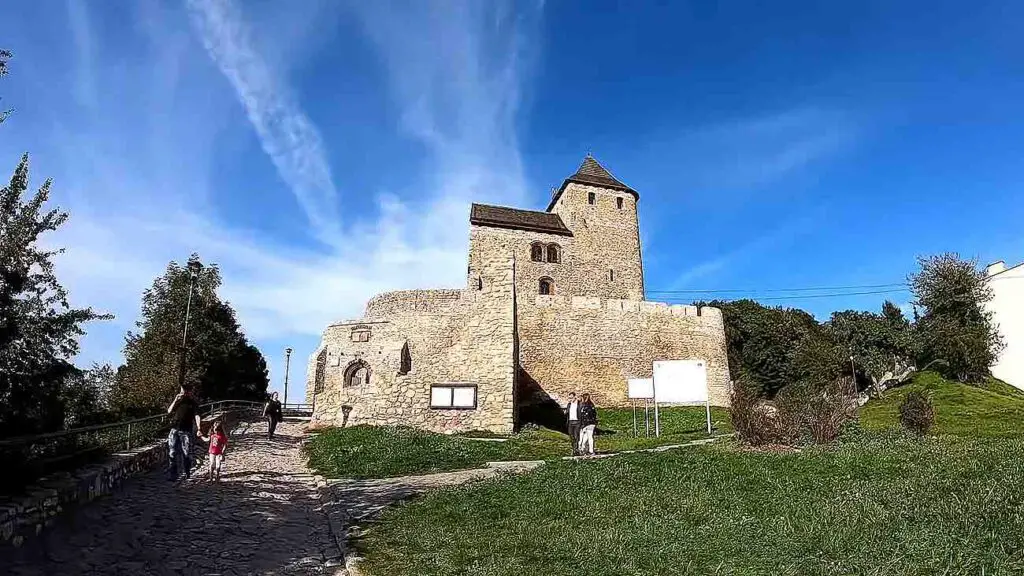
The medieval fortress of Będzin Castle, with its stone walls visible from afar, lies on the border of Lesser Poland and Silesia, making it a strategically important point on the map of Polish fortresses.
Ogrodzieniec Castle
Built in the 14th century atop the highest hill of the Kraków–Częstochowa Upland, Ogrodzieniec Castle was rebuilt in the 16th century and expanded until the 17th century when the Swedes invaded.

Despite its advanced defense systems, the Swedes captured, looted, and destroyed the castle. After the Deluge, it fell into disrepair, and by 1810, the last owner left because the ceilings were on the verge of collapsing.
Today, the “permanent ruin” is restored and open to the public. Regional events like knight tournaments take place here, and it has served as a filming location for series and films such as “Janosik” by Jerzy Passendorfer and “Revenge” by Andrzej Wajda.
Despite the damage, Ogrodzieniec Castle towers majestically over Podzamcze, and countless legends are associated with it, like the castle well and the black dog.
Mirow and Bobolice Castles
Along the Trail of the Eagles’ Nests, defensive strongholds built by Casimir the Great in the 14th century, lie neighboring castles Mirow and Bobolice, both owned by the Lasecki family. Mirow is a picturesque ruin undergoing reconstruction, while Bobolice is a restored castle housing a museum and, as warned by a plaque at the gate, haunted by ghosts.

Legend has it that both castles belonged to twin brothers. One day, a knight from Bobolice returned from war with immense riches and a beautiful captive, who soon fell in love with her captor’s brother from Mirow.
They secretly met in a corridor connecting the two castles, where the betrayed Bobolice knight killed and buried his brother and unfaithful lover and hid the war treasure. However, the treasure was never found, and there are no official records of the corridor. Yet, people talk, archaeologists come, and research is conducted.
Mount Zborow
Mount Zborow, according to old legends, was a gathering point for witches before they left for the Sabbath at Łysa Góra in the Świętokrzyskie Mountains. The landscape here is dominated by karst phenomena such as caves, ravines, dry valleys, rock bands, and limestone hills.

Among these, the Kroczyckie Rocks and the nearby Kołoczek hill form an inanimate nature reserve, known as Góra Zborów or Góra Berkowa. This area is home to some of the most picturesque rock monadnocks in the entire Kraków–Częstochowa Upland.
If you want to visit, the Góra Zborów reserve is located north of the village of Podlesice, 50 km south of Częstochowa and 16 km north of Zawiercie.
During a trip to Góra Zborów, you can admire the wonderful panorama of the area, explore rock crevices, play stalking games among the monadnocks, or watch rock-climbing enthusiasts. If you are lucky, you may spot kestrels, swifts, and gray wagtails nesting in the rocks or a smooth snake basking in the sun.
It is worth saying that the smooth snake, often mistaken for an adder, is a non-venomous snake protected and listed in the Polish Red Book of Animals.
At the foot of Raven Rocks, you will find the intriguing Głęboka Cave. Discovered in 1942 due to calcite mining and later limestone quarry operations, it is open daily from mid-April to the end of October.
In winter, it serves as a resting place for bats, including the lesser horseshoe bat, brown long-eared bat, and large long-eared bat. You may also encounter a large cave web spider on the walls.
Rzędkowice Rocks
Located in the western part of Ostoja Kroczycka, the Rzędkowice Rocks consist of a series of inselbergs resembling a rock chain. The range is dominated by Skala Wysoka and Wielki Okiennik, the most interesting and beautiful monadnock of the Jura.

This structure is actually a remnant of an ancient system of caves carved by an underground river that once flowed at this level. Stone tools from 60,000 years ago were found at the entrance to a cave below the window.
Pieskowa Skała Castle
Built by Casimir the Great on a rock called Dorothy, the castle in Pieskowa Skała served as a watchtower protecting the Kraków–Wrocław trade route. Three centuries later, it was significantly expanded and transformed into a typical Renaissance magnate seat.

Today, it houses a branch of the Wawel Royal Castle Museum and is open to visitors year-round. There is also a café, which provides access to the bastion, a fantastic vantage point. Surrounding the residence is a park, and below, you can see Prądnik and Hercules’ Club.
If you need a break from the hustle and bustle of daily life, visiting these historical and natural sites can provide a much-needed escape. Not only will you learn about the rich history of the region, but you will also have the opportunity to immerse yourself in its breathtaking natural beauty.
Hercules’s Mace in Ojcowski National Park

The club of Hercules, or Hercules’s mace, is a symbol of the Ojcowski National Park and the Jura Krakowsko-Częstochowska. It is a limestone monadnock in the shape of a huge club, standing 25 m high. Legend has it that the rock was set up like a club by the devil himself, at the request of Twardowski.
Zalipie – The Painted Village
Zalipie is a small village located near Tarnów. It is a quiet and peaceful place, known for its painted huts. Houses, fences, wells, and kennels are all painted here. While some say that not all enclosures are decorated, finding the colorful ones is not difficult.

Moreover, there are no souvenir stalls or a fair atmosphere here. On a Sunday morning in August, the village lived its quiet, idyllic rhythm. It is clear that the inhabitants cultivate this tradition for themselves, not for tourists.
Krakow Market
Krakow, a pearl of national heritage, was the capital of Poland until 1795. It was the seat, the coronation city, and the necropolis of kings. It is where the first university in Poland, the Krakow Academy (today the Jagiellonian University), was founded.
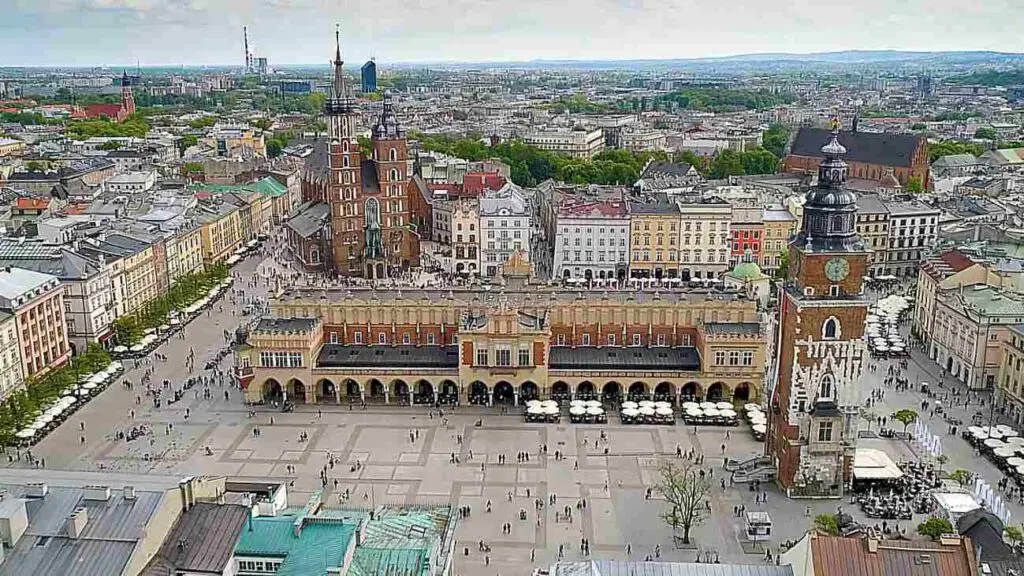
In this city, you can feel the breath of history at every step, and art and architecture peek out from around every corner. The Main Square, the largest medieval square in Europe, was laid out during the city’s location in 1257. It was then that a chessboard of streets was created.
Trade in the Sukiennice dates back to the 13th century. Mainly cloth was traded, hence the name of the famous market hall with arcades standing in the middle of the Krakow Market Square.
The uneven towers of St. Mary’s Basilica have towered over Krakow’s market square for centuries. From the higher tower, at every full hour, the sounds of the bugle call played to the four corners of the world flow.
Inside, you can admire the altar of Wit Stwosz from the end of the 15th century, a priceless work of late-Gothic sculpture on which the master worked for 12 years. The whole interior is decorated with amazing 19th-century polychromes by Jan Matejko, Józef Mehoffer, and Stanisław Wyspiański.
In the middle of the Market Square stands a statue of Adam Mickiewicz, unveiled in 1898.
Wawel Royal Castle
Situated on a limestone hill in the bend of the Vistula River, the Wawel Royal Castle witnessed great history. Its architectural heyday was during the reign of Sigismund the Old, who transformed the 14th-century building into a Renaissance residence, a testimony to the power of the last Jagiellonian dynasty.
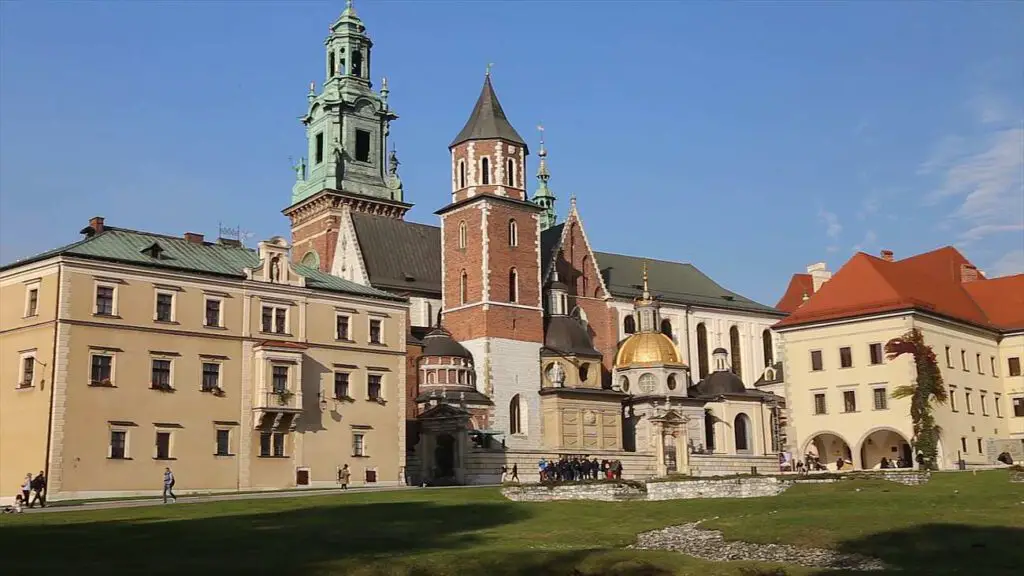
Prominent Italian architects erected a four-winged palace with an arcaded courtyard. The chambers were decorated with tapestries woven in Flemish.
The coronations of kings took place in the Wawel Cathedral, where seventeen Polish rulers, the ashes of bards, national heroes, and others are buried in the basement.
If you are there, you should know that the history of Poland is deeply intertwined with these places, and a visit will give you a glimpse into the country’s past, its culture, and its traditions.
Kazimierz – Kraków District
Kazimierz, today, is a captivating place with its tangle of streets, atmospheric tenement houses, and cafe gardens. It was founded in 1335 by King Casimir the Great (hence the name) as a separate city but was incorporated into Kraków only at the end of the 18th century.

From the 15th century to World War II, the Jewish population lived there, which is why there are many Jewish monuments here, including as many as 7 synagogues and a historic Jewish cemetery.
Most of the Jewish culture monuments are located at ul. Broad. But it is best to wander aimlessly around Kazimierz. Look into the gates, read the old and new signboards, and see the murals. It is worth sitting down somewhere for a coffee or a glass of wine.
Wieliczka Salt Mine
The history of salt mining in Wieliczka dates back to the mid-13th century, and the oldest shaft was built in 1280. It is the only mine in the world that has been operating continuously from the Middle Ages to the present day. The mine consists of nearly 300 km of corridors, 3,000 chambers, including magnificent chapels hollowed out by miners, and underground lakes.

The chapel of St. Kinga, hollowed out at the end of the 19th century and located 101 m underground, is illuminated by magnificent salt chandeliers, and the walls are decorated with scenes from the New Testament. The Baroque chapel of St. Antoniego is a work from the 17th century, and at a depth of 125 meters, in the Budryk chamber, there is a mining inn.
Lesser Poland Wine Route
Have you heard about the reviving tradition of viticulture in the southern regions of Poland? It is in Małopolska that the most vineyards are registered.
This region is where the tradition of viticulture and wine production is most dynamically revived, and the history of wine in Poland begins. The Małopolska Wine Trail was created to promote this wine renaissance and today, it brings together 50 smaller and larger local wine producers.

Together with VeloWino, we set off on a journey full of Lesser Poland landscapes, flavors, and aromas, along the road leading from Krakow through the Vistula Valley, the Tenczyn Castle in Rudno to the Jura vineyard and Zagrabie.
The journey was just over 45 km along the undulating roads and wilderness of Lesser Poland, crowned with a wonderful tasting and a bonfire among the vines. We returned safely to Krakow late at night by public transport bus.
Tenczyn Castle in Rudno
This Jurassic stronghold, in the years of its splendor, competed with Wawel in its appearance and importance. The castle was built in the fourteenth century during the times of Władysław Łokietek and then included by Casimir the Great in the so-called Eagle’s Nests, a system of castles guarding the border of the Kingdom of Poland in the Middle Ages.

The first wooden stronghold was built here around 1319 by the castellan of Kraków, Nawój z Morawica, the progenitor of the Tęczyński family.
Today, Tenczyn Castle is secured, partly rebuilt, and made available to visitors as the so-called permanent ruin. Entrance to the area is payable and possible at set times.
Morskie Oko Pond
Morskie Oko is the largest and most famous Tatra lake, with an area of 35 ha and a depth of up to 50 m. It is the only naturally stocked Tatra lake on the Polish side. Legend has it that it connects an underground river with the Adriatic.
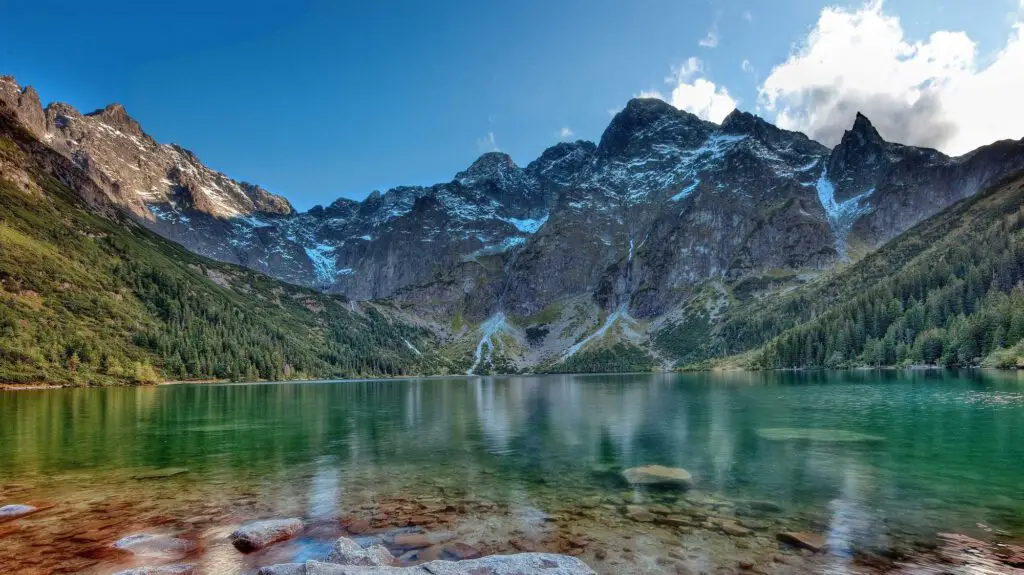
On a summer day full of the hustle and bustle of tourists, it quiets down in the evening. And the world wakes up with the sun shining and birds singing. It is worth spending the night in a hostel and getting up at dawn.
Peace and quiet, only the chirping of birds and the Mięguszowieckie Peaks reflected in the pond, bathed in the morning sun. Empty. Only this time brings out the true beauty of this place.
Roztoka Valley – Waterfall And Valley of Five Polish Ponds
This trail is surely one of the easiest and most beautiful in the Tatras.
The Roztoka Valley starts with Mickiewicz’s Waterfalls, then leads through a wild forest along the Roztoka Stream. This is one of the best preserved natural forests in the Tatras, with trees estimated to be 300-400 years old. After leaving the forest, the trail leads among rocks and mountain pine.
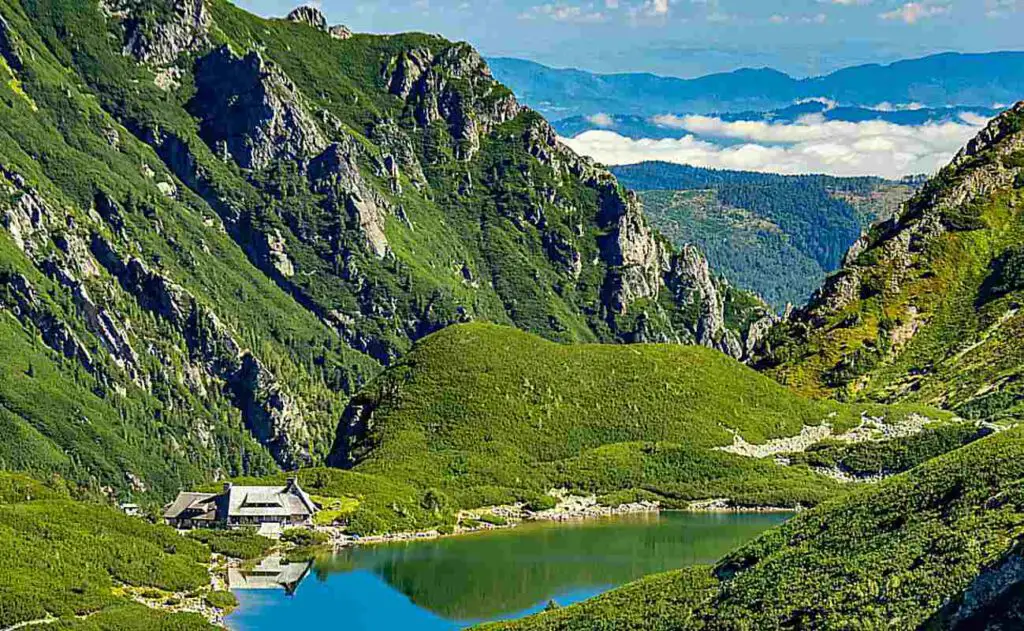
Next, you will reach Siklawa, the largest waterfall in the Polish Tatras.
At an altitude of over 1,625 m above sea level, lies one of the most beautiful valleys in the Tatra Mountains – the Valley of Five Polish Ponds. It is named after five picturesque, glacial lakes and is dominated by Świnica, Szpiglasowy Wierch, and the ridge of Orla Perć.
You can reach Morskie Oko for the night through Świstówka or spend the night in a shelter in the Valley of Five Polish Ponds.
Chochołowska Valley
The longest valley in the Tatras, it stretches for 10 km and ends with a shelter on Polana Chochołowska, from which you have a beautiful view of the vertical rock spiers – Mnichy.
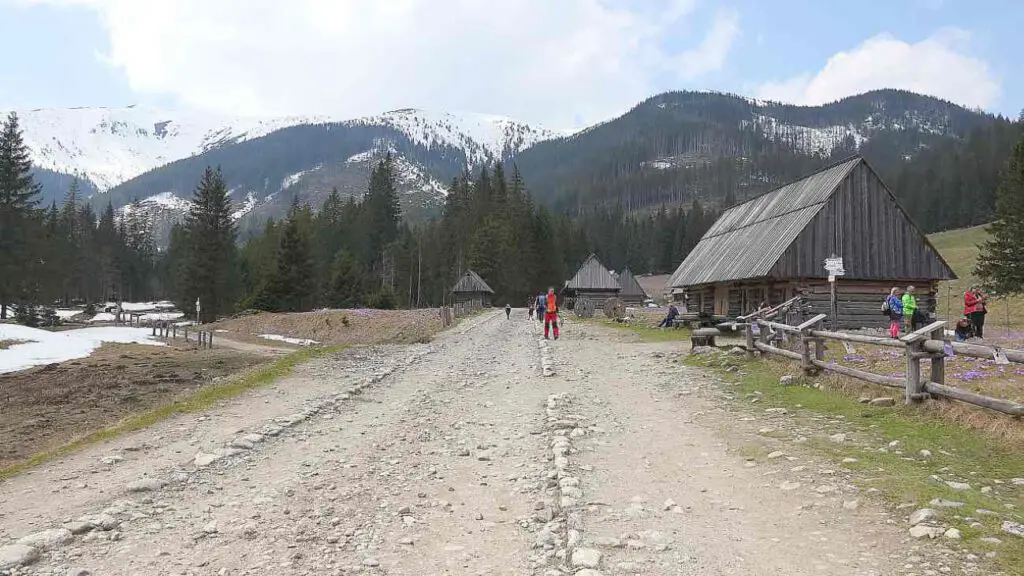
The valley is named after the nearby village of Chochołów, from where shepherds grazed sheep. It was the setting for the sleigh ride scene in Deluge and one episode of Janosik.
Today, thousands of tourists come here in early spring to see the blooming crocuses. I, too, would like to see that, but I don’t have the courage… I’m afraid that what I’ll see may destroy my childhood memories…
Pieniny Mountains
The Pieniny Mountains are beautiful and worth visiting even for a few days. Trzy Korony is the highest peak of the Central Pieniny Mountains. Castle Mountain is shrouded in legends. And finally, Sokolica with the most famous pine tree in Poland.
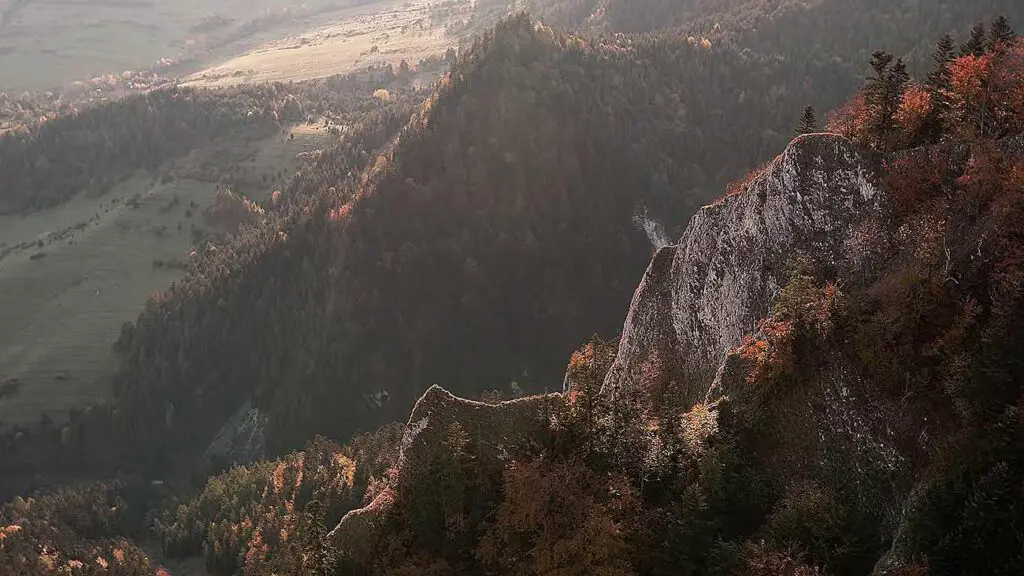
Both from Trzy Korony and from Sokolica, the views of the Dunajec gorge are breathtaking. In good weather, you can also see the panorama of the Tatra Mountains.
Dunajec River and Rafters
Between Sromowce Niżne and Szczawnica, the Dunajec River forms a picturesque rock gorge. It is 9 km long and has as many as 7 sharp turns. Legend has it that the Dunajec gorge was cut down by Bolesław Chrobry with a sword.

Rafting on the Dunajec river is also an undeniable attraction. Although today it is a typical tourist mass, and the raftsmen no longer deal with river rafting of goods, but with the transport of tourists – it is colorful and fun. And the views of Trzy Korony and Sokolica from the water level are wonderful.
Redyk in Szczawnica
Redyk, i.e., the herding of sheep from pastures for the winter (autumn) or taking them to pastures (in spring).
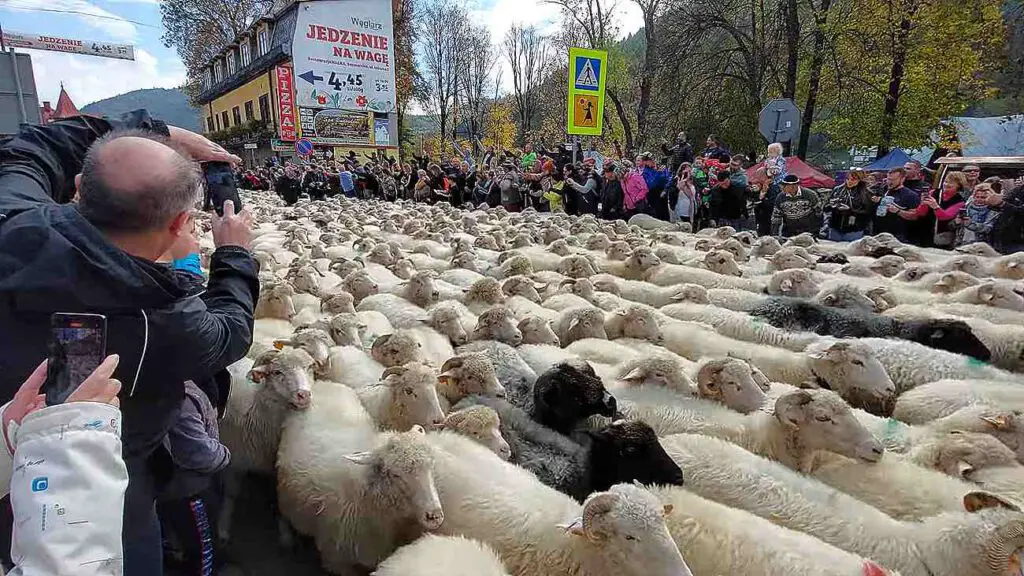
Every year, about 2,000 sheep and rams march along the main street of Szczawnica. The march is accompanied by folklore groups as well as highlanders and highlanders in traditional costumes riding in horse-drawn carts. Shepherds and shepherds, as well as shepherd dogs, of course, go with the herd.
Niedzica Castle
This picturesque, 14th-century castle rising on a steep rock used to be called Stary Dunajec. Today, it overlooks Lake Czorsztyńskie – an artificial reservoir created as a result of the construction of a flood dam on the Dunajec River in the 1990s.

The castle was built as a small knightly stronghold of a Hungarian prince whose task was to defend the border with Poland.
This castle is also related to the story of Umina – the daughter of an Inca princess and a descendant of the owners of the Niedzica castle, who fled from the Spaniards with her son to Niedzica. Here she died, but the child survived and was adopted.
The quipu found in 1946 – an Inca knotted script, where the inscriptions “Vigo”, “Titicaca”, “Dunajecz” were supposedly written on three gold plates intertwined with thongs – also lost. The report of his finding – burned down.
A man claiming to be a descendant of Tupac Amaru – died in an accident. Is it history or already a legend? Where is the border? Maybe someday we’ll find out.
Rabka Zdrój – Steam Locomotives and Health Resorts
Rabka Zdrój is well-known as a health resort for kids, thanks to its mineral waters and mild microclimate. Just a bit away, in Chabówka, there’s an incredible open-air museum dedicated to steam locomotives and railway history.

Back in the day, 80 steam locomotives that operated passenger and freight trains to Kraków, Nowy Sącz, and Zakopane were stationed there. Now, you can see all kinds of locomotives, wagons, snow plows, and railway cranes. And don’t miss Parowozjada in August, a parade of historic steam locomotives. You can even take a ride on a retro train on the Chabówka – Nowy Sącz route. Check out www.parowozy.pl for more info.
Bochnia Salt Mine
The Bochnia Salt Mine, created in 1248, is tied to the legend of Saint Kinga and her ring. It’s said that Kinga, a Hungarian princess, wanted to bring salt as a dowry to her new homeland, Poland. So, she threw her engagement ring into the Marmorsz mine and set off.
When she arrived in Poland and miners dug for salt, they found her ring inside a lump of salt extracted from the Bochnia mine. Today, the mine serves as a tourist and healing facility. You can even spend New Year’s Eve there or organize a conference.
The Ważyn chamber, the largest underground room in Europe, has a healing room with a unique microclimate. There are even playgrounds for children staying in sanatoriums and going underground for sessions.
Krynica Zdrój – Town
Krynica Zdrój is surrounded by the youngest mountains in Poland, the Beskids: Sądecki and Low. These mountains were formed during the last phase of the Alpine folding, about 20 million years ago. Krynica is mainly a health resort with a promenade, Spa Park, and a statue of Adam Mickiewicz.

But it’s also where Nikifor, a famous primitivist painter of Lemko origin, lived and worked in poverty and solitude. He was considered mentally ill. Nowadays, the Romanówka villa houses Nikifor’s museum, where several dozen of his works are collected.
A Night at Bacówka nad Wierchomla
If you want an unforgettable adventure, spend a night at the Bacówka nad Wierchomla, a PTTK mountain tourist hostel. It’s at 887 m above sea level, on a vast clearing with slopes descending to the valley of Wierchomla Mała.

You can enjoy amazing views of the Radziejowa range and the Tatra Mountains panorama. There’s something special about an evening bonfire, sunset, and sunrise in the mountains. It’s in moments like these that you can feel the mountains’ realness, majesty, and peace.
You can sync with nature’s rhythm and terms. And in winter, Wierchomla turns into one of the best Polish ski resorts.
Swietokrzyskie Mountains
The Swietokrzyskie Mountains are the oldest in Poland, made of the hardest rocks found in the country. These rocks are from the bottom of a sea that existed here several hundred million years ago. While walking the trails, you might find pieces of quartzite on the ground.

The highest range of the Świętokrzyskie Mountains are the Łysogóry. The west’s highest peak is Łysica (612 m above sea level), and in the east, it’s Łysa Góra or Święty Krzyż (594 m above sea level). Legend says witches’ sabbaths were held here. Scientists believe there was a Slavic religious center here.
Chęciny’s Royal Castle
The Royal Castle in Chęciny is a fascinating monument in the Świętokrzyskie Voivodeship. Its three towers are visible from afar. Though now a “permanent ruin”, it was once a political life center. It’s where Władysław Łokietek left for the great battle of Płowce and where he left the crown treasury, fearing the Teutonic Knights.

Queen Bona also gathered her treasures here before leaving for Italy. Rumor has it, some valuables hastily left behind by her still lie in the underground dungeons. The castle also appeared as the fortress in Kamieniec Podolski in the film “Pan Wołodyjowski” by Jerzy Hoffman.
It’s best to visit in the off-season to avoid crowds. On clear days, you can even see the Tatra Mountains’ peaks.
Sandomierz Town
Sandomierz, picturesquely located on the Vistula escarpment and the Świętokrzyskie Mountains’ steep end, is a Polish Renaissance pearl. One of Poland’s most beautiful and oldest cities, it gained city rights in 1227.

As a royal city, it was on king-owned land. It’s on seven hills, earning it the nickname “Little Rome.” Besides the Market Square and Town Hall, attractions include a castle, the Queen Jadwiga Gorge, an underground tourist route, and the Pepper Mountains.
Dinosaurs at Jura Park in Bałtów
Jura Park in Bałtów is a tourist complex opened in 2004 in the Świętokrzyskie Voivodeship. The park features life-size dinosaur reconstructions, with over 100 reptiles on display. Guides share fascinating prehistoric insights, and you can even play paleontologist and dig up part of a skeleton.

There’s also a 5D cinema, where the chairs rock, and you can smell and feel “something” in addition to seeing and hearing the film. It’s incredibly fun for kids, but adults won’t be bored either.
Neolithic Flint Mines in Krzemionki

Krzemionki is a complex of mines where flint was mined during the Neolithic (late Stone Age) and early Bronze Age, between 3900 and 1600 BC. It’s the only tourist-accessible site of its kind in the world, serving as an archaeological reserve and historical monument.
Opatów’s Underground City
Opatów has a network of underground corridors beneath its houses, streets, and market square. These cellars, used as merchant warehouses since the Middle Ages and especially in the 16th and 17th centuries, are at the crossroads of major trade routes.

Today, about 500 meters of the underground tourist route on three levels is open to the public. And while in Opatów, don’t miss the monumental collegiate church of St. Martin.
Krzyżtopór Castle in Ujazd

Actually a palace, Krzyżtopór in Ujazd was built mainly for representative functions in the early 17th century by the Stopnica staroste, Krzysztof Ossoliński, coat of arms Topór. It’s said the building had as many windows as days in a year, and the tower had a dining room with a glass ceiling for observing an aquarium with exotic fish.
Jarosław – Town
Jarosław lies in Podkarpacie in the San valley. Its founder is thought to be Jarosław the Wise, prince of Kiev, who fought the Piast state over these lands for years. Trade brought the city its greatest wealth, especially the annual August fairs that attracted global merchants at the time. It is believed that these fairs, along with the Frankfurt ones, were Europe’s most important.

To store various goods, extensive cellars were built under the Jarosław tenement houses, serving as warehouses and natural refrigerators. However, Jarosław also has a history of war and construction disasters, leading to almost complete city annihilation.
Today, it’s a small, quiet town where Grodzka Street trade still thrives, and the August fairs tradition continues. If you are there, I especially recommend the Underground Tourist Route.
Przemyśl
In the picturesque valley of the San River, Przemyśl is a royal city on the hills. A former principality capital, it’s a multicultural city due to its proximity to Ukraine. Today, it’s the seat of both the Roman Catholic and Byzantine-Ukrainian Archbishoprics.

The Old Town has preserved its historic spatial layout. The market square has alleys, lawns, and benches under shady trees. Surrounded by wonderful tenement houses, some restored and others awaiting restoration. Venture further into the old town to find more tenement houses and churches.
These include the Baroque Franciscan Church, the Greek Catholic Cathedral, and the Roman Catholic Cathedral. Also, the Carmelite Church and Monastery, and the Reformers’ Church. Overlooking the town is the castle of Casimir the Great, and even higher, the Tatar Mound.
Castle in Krasiczyn
A Renaissance and Mannerist architecture pearl, built by Stanisław Krasicki at the 16th and 17th centuries’ turn. It was owned by eminent Polish aristocratic families like The Modrzewskis, Tarłów, Potockis, and Sapiehas.

The castle’s most characteristic element is its four corner towers – Divine, Papal, Royal, and Noble. Each symbolizes a hierarchy level of the then world. The openwork parapets, created with a special technique of painting and scraping, are also amazing.
Inside, the castle is practically empty due to the Red Army’s plundering at World War II’s end. Book collections were burned, furniture chopped and burnt, and the Sapiehas’ graves destroyed and smashed.
Łańcut Palace
One of Poland’s most magnificent aristocratic residences, erected in the mid-seventeenth century by Stanisław Lubomirski in the fashionable palazzo in fortezza style. After Izabela Lubomirska née Czartoryski’s reconstructions, Łańcut flourished in the 18th century’s end.

However, the palace began to fall into disrepair in the following years. Its splendor was restored at the 19th and 20th centuries’ turn by successive owners – Roman Potocki and his wife Elżbieta née Radziwiłł.
A general renovation was carried out, resulting in a modern residence for those times. A water supply and sewage system were installed, and the building was electrified. The Rose Garden and the Italian Garden were created.
Baranow Sandomierski
Known as Little Wawel, it’s a Renaissance architecture pearl. Owned by families like the Leszczyński, Lubomirski, Małachowski, Potocki, Krasiccy, and Dolański.

In the 15th century, the local manor belonged to the noble Baranowski family. The Górka family became the owner at the 15th and 16th centuries’ turn, and in 1569, Rafał Leszczyński acquired the property.
Fascinated by Wawel’s architecture, he transferred its character to the local ground, resulting in numerous cloisters and arcades.
If you want to immerse yourself in history and architecture, these places are a must-visit. I believe the beauty and historical significance of these locations will leave you in awe.
Bieszczady’s Pastures and Routes
So you’re probably wondering, what’s so cool about Bieszczady, right? Well, I can tell you it’s where the wild things are. Imagine being in a place where you can bump into deer, wolves, or even bears!
I know, it sounds like something out of a fairy tale. But Bieszczady is real, and it’s one of the most peaceful places in Poland where you can actually escape and chill with nature.

The forests here don’t climb as high up the mountains as they do in other places. Instead, you get these amazing grassy meadows called pastures. You should know that Bieszczady in autumn is like an artist’s palette—red grass, hillsides in shades of yellow, gold, bronze, and purple. Totally worth a visit, I’m sure.
There’s this route from Tarnica to Halicz to Rozsypaniec. Yeah, it’s a long name but trust me, the views are something else. You start from a place called Wołosaty and then trek up into the forest. After a lot of “up”, you hit these beautiful pastures and get views that make you feel like you’re on top of the world.
What makes Tarnica special? There’s a cross at the summit to remember a climb by Fr. Karol Wojtyla in 1953. That’s right, the same guy who later became Pope John Paul II. And the panorama? Wow, you can see for miles, even into Ukraine. By the time you reach Rozsypaniec, you’ll be tired, like really tired. But it’s worth it, a hundred times worth it!
Lake Solina

If trekking isn’t your thing, no worries. Head over to Lake Solina. It’s where you’d want to be if you’re into sunbathing or sailing. You can even check out the inside of the hydroelectric plant. That’s not something you do every day, right? And walking atop the dam gives you a totally different view of the lake.
Szklarska Poręba
Let’s switch gears and talk about Szklarska Poręba. This place has always been about glass. Why? Because it has loads of quartz and wood, that’s why. The town itself is a year-round resort.

But what’s cool is you can actually see people blowing glass at Leśna Huta. Yup, making things like jugs, birds, and cats. You can even try your hand at it if you want.
If you thought Szklarska Poręba was just about vacations, think again. Julia glassworks is one of the few places in Poland where they still make crystal. And you can watch the whole process. Imagine watching a blob of molten glass turn into something beautiful right in front of your eyes. Mind-blowing, I’m sure. After the tour, if you’re feeling inspired, you can take part in glass workshops.
Szklarki Waterfall
Nestled in the central part of the Szklarki Gorge, lies the Szklarki Waterfall at an altitude of 520 meters above sea level. The water plunges down a cascade that narrows and twists into a spiral, with a water jet height of 13.3 meters. If you want a bit of history, I can tell you that the first mention of this waterfall goes back to the Middle Ages.

Over the centuries, it was captured in descriptions, engravings, and paintings because of its romantic and beautiful nature. In 1868, an inn was constructed beside the waterfall, eventually evolving into the present-day Hostel “Kochanówka”.
Kamieńczyk Waterfall
The Kamieńczyk Waterfall is the tallest in the Polish Karkonosze Mountains. Situated at 843 meters above sea level, the water cascades down in three stages from a 27-meter height into the Kamieńczyk Gorge.

Although the gorge is just about 100 meters long, its vertical rock walls tower over 25 meters high. In spots where the gorge narrows to less than 4 meters, it feels mysterious and enchanted. I think it is worth to say that scenes from “The Chronicles of Narnia: Prince Caspian” were filmed here.
Jizera Railway
The Jizera Railway is the railway link between Poland and the Czech Republic, connecting Jelenia Góra, Szklarska Poręba, Harrachov, and Korenov. Built in the early 20th century and reopened in 2010 after a 65-year hiatus, it is regarded as one of Poland’s most fascinating railway lines.
Mountain cliffs, fauna, and flora of the Jizera Mountains are almost within arm’s reach, making the journey on the Izera Railway a fantastic attraction.
Table Mountains
The Table Mountains are a range in the Central Sudetes chain. Formed 30 million years ago, they are the only plate mountains in Poland, composed of horizontally arranged yew sandstone slabs – hence the name, “flat as a table”.
In 1993, the Stołowe Mountains National Park was established, showcasing spectacular rock formations, corridors, labyrinths, and monadnocks.

Errant Rocks, a maze of cracks and alleys, sometimes incredibly narrow, separates rock blocks several meters high. The Rock Mushrooms and other formations are so astonishingly shaped that they have been named.
A walk among them is a remarkable adventure. Moreover, in August, you can enjoy enormous, tasty, and juicy berries in the Stołowe Mountains.
Kudowa Zdrój – Health Resort, Skull Chapel
Kudowa Zdrój is primarily known as a health resort with a climate that positively impacts blood circulation, respiratory, digestive, nervous systems, and muscle efficiency. Established in the 18th century, the Spa Park and mineral water pump rooms helped Kudowa flourish in the 1920s. Today, it remains a popular spot where it’s worth pausing and spending some time.

Kudowa is also famous for the Skull Chapel, a unique facility in Poland and one of only three in Europe (the others being in Niš, Serbia, and Evora, Portugal). It’s a common tomb for victims of the 18th-century Silesian wars and infectious diseases.
The walls and ceiling are adorned with three thousand human skulls and bones, while tens of thousands of remains lie beneath the floor. Built in 1776, the chapel leaves a staggering impression, but it is worth visiting.
The Trail of Disappearing Professions is hosted by Urszula and Bogusław Gorczyński on their farm. Here, you can witness pottery, blacksmithing, manual butter production, a zoo, a windmill, and a handicraft hut.
The bread house features a wood-burning oven where bread is baked. If you’re there, volunteers can craft their own bowl on a potter’s wheel, and I can tell you, the fresh bread with lard is simply irresistible! One of the rooms displays folk costumes from various Polish regions, and the yard showcases numerous appliances once used on farms.
Złoty Stok Gold Mine
Złoty Stok is not just one attraction, but a series of exciting experiences!
First, there is the mine tour, where, besides the adit gallery, you’ll discover a treasury, a workshop, and an underground waterfall. The journey unfolds on the Underground Orange Tram.

Another thrilling activity is panning for gold yourself.
A bit further, you’ll encounter the so-called Diamond Fields, where you can search for minerals in the sand.
Additionally, you can time travel to the Middle Ages at the Medieval Mining Settlement. This is a 1:1 scale replica of a medieval settlement, complete with functioning treadmills and water wheels. You will also explore an underground tunnel filled with secrets and fears, concluding with a visit to the Executioner’s Cottage.
The Bear Cave
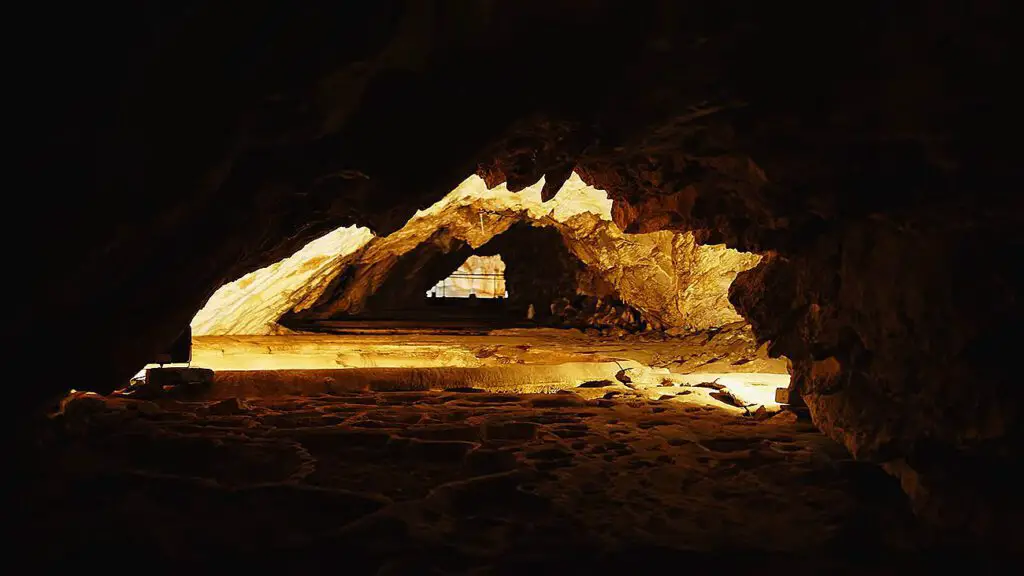
The Bear Cave is in the village of Kletno. It is the longest cave in the Sudetes and one of the deepest and longest in Poland. The known length of its halls and corridors exceeds 5 km, and its depth surpasses 100 meters.
The cave comprises three levels: the first is only partially preserved; the second marks the tourist route; and the third, the deepest, is inaccessible to visitors.
The tourist route showcases a trail abundant in well-preserved dripstones, and a significant amount of Ice Age animal bones, with the majority being cave bear remains.
Nowa Ruda – A Tourist Coal Mine
A visit to the mine in Nowa Ruda consists of two parts: the museum and the underground. The museum halls provide insights into coal, mining history, and the local miners’ work. Here, you’ll learn why the Nowa Ruda mine was considered Europe’s most dangerous and also get a glimpse of the control room.

Donning protective helmets, you’ll venture underground, where you can not only see but also touch the mine and even work with mining tools. You will encounter a conveyor, a harvester, a jackhammer, and a ventilation duct.
The guide will share stories about the miners’ work and the tragic fate of horses. At the journey’s end, you’ll exit the mine on an authentic mining railway.
Osówka – The Mysterious Town
Who hasn’t heard of Książ Castle or the underground City of Osówka? Probably everyone, especially if you’re into mysteries and unknown histories. Located in the Owl Mountains, within the Włodarz massif, the Osówka complex consists of concrete corridors, fortifications, and halls, constructed on a massive scale since 1943.

It is a part of the “RIESE” complex. The purpose of the construction was kept top secret, and we still don’t know everything about it.
Some historians believe it was meant to be Hitler’s largest headquarters, not only in Lower Silesia but in the entire Reich. Others think the halls were built for underground armaments factories to produce secret weapons.
What we do know is that workers and prisoners from the Gross-Rosen concentration camp were used for the construction. Surface defense systems and underground tunnels were built in various places. However, work was halted in early 1945 due to the approaching Red Army and the Polish Army.
Szklary – Former Nickel, Opal, and Chrysoprase Mine
In 1890, a mine was opened in Szklary, extracting nickel ores and precious gemstones like green chrysoprase, milky white opals, and red carnelian. Frederick II the Great, King of Prussia, was particularly fond of these stones. The nickel was intended for making durable, strong, and stainless bombs, mines, and cannons.

Interestingly, the only other place in the world with deposits of such minerals is currently Australia. The mine was eventually closed in 1993, and Szklary slowly turned into a ghost town with more abandoned buildings than inhabited ones. Today, the mine operates as a tourist attraction.
Wrocław – City
Wrocław is one of the oldest cities in Poland. From the end of the 10th century, it was ruled by the Piast dynasty and was a major seat of the kingdom. In 985, the first stronghold built by Mieszko I was established on Ostrów Tumski. It was first mentioned in 1000 during the establishment of a bishopric at the Gniezno convention.

In the medieval Chronicle of Poland by Gallus Anonymus, Wrocław, along with Kraków and Sandomierz, was listed as one of the three main capitals of the Kingdom of Poland. The Via Regia and the Amber Route, two major trade routes, crossed here. The city was also part of the Hanseatic League.
In 1335, after 350 years of rule by Polish princes and kings, Wrocław came under the rule of the kings of Bohemia.
Following the death of Louis II Jagiellon in 1526, Wrocław, along with the Kingdom of Bohemia, was incorporated into the Habsburg monarchy.

In 1741, during the Silesian Wars, King Frederick II captured the city, along with most of Silesia, and it became part of Prussia.
In 1945, at the Potsdam Conference, it was decided to transfer Silesia, including Wrocław, to Poland.
Today, Wrocław is a thriving city, full of monuments and modernity. In 2016, it was the European Capital of Culture.
Wrocław’s Market Square is one of the largest in Europe. The central part houses the Old and New Town Halls, while the western part features Renaissance and Mannerist tenement houses. It is bustling with restaurants, cafes, street vendors, and artists.

The oldest part of Wrocław is Ostrów Tumski, an island accessible via a steel bridge. When Bolesław the Brave established a bishopric here in 1000, a cathedral and a princely castle were built on Ostrów a few years later.
Karpacz – A Town with a Norwegian Temple
Karpacz is nestled in the Karkonosze Mountains, right at the foot of Śnieżka. It’s a ski resort in winter and a mountain tourism hub in summer. But, there’s more to Karpacz than just slopes and trails.
One of the main attractions is the Wang Temple, situated on a hill. This church was originally built in the 12th and 13th centuries in Vang, Norway. Frederick William IV bought it in the 19th century and had it shipped to Szczecin, intending to take it to Berlin.

However, it ended up in the Karkonosze Mountains, serving as a Protestant temple. What’s fascinating is that it is an entirely wooden structure, built without any nails. A stone belfry was later added in Karpacz.
Chojnik Castle
Some say the Bobrzan tribe had a stronghold on Mount Chojnik. What we do know is that Bolesław Łysy-Rogatka built a hunting manor here in the 13th century. Bolko I the Strict expanded it into a castle.

Standing on a rocky peak 627 meters above sea level, the castle was nearly impossible to conquer. Despite many attempts, it remained undefeated. Unfortunately, lightning struck in 1675, causing a fire that destroyed it.
If you are there, the climb to the castle is tough but rewarding. The castle tower offers stunning views of the Karkonosze, Jizera, and Rudawy Janowickie. You can even try shooting a crossbow and receive a certificate or dress up as a knight. Every August, a Crossbow Tournament for the Golden Bolt of Chojnik Castle is held.
Czocha Castle
Czocha Castle was built in the 13th century by Czech king Wenceslaus II. In 1315, Piast prince Henry I Jaworski married Czech princess Agnes and received the castle and surrounding lands as a dowry. Over centuries, the castle transformed from a military stronghold to a knightly residence. A fire in 1793 left it in ruins, but it was rebuilt in the 20th century.
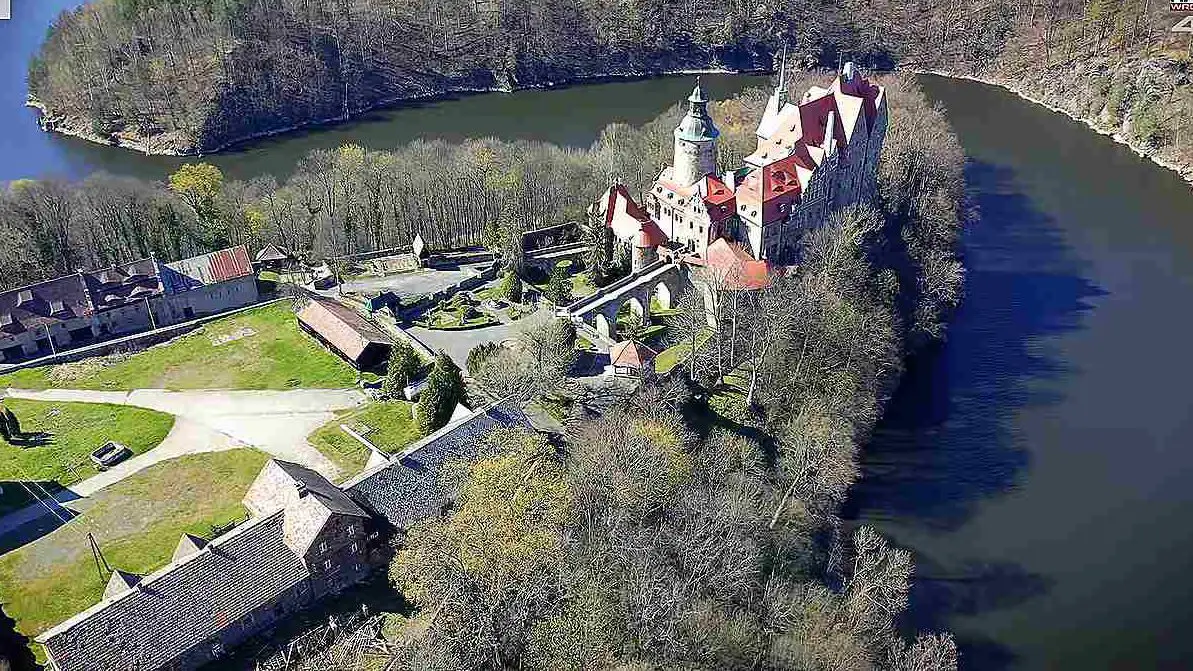
During World War II, it was a heavily defended Nazi fortress, suspected of being a site for missile weapon research. Bogusław Wołoszański believes German cryptologists here decrypted Soviet codes and built a decryption machine, the “sword fish”, during the war.
In the Polish People’s Republic era, it was a holiday center for prominent figures like Bierut, Gomułka, Cyrankiewicz, Jaruzelski, Koniew, Żukow, and Rokossowski.
Since 1996, it has been a hotel. The castle served as a backdrop for many films and series, including Where is the General?, The Witcher, The Legend, A Backpack Full of Adventures, The Secret of the Cipher Fortress, and Two Worlds. By 2017, it had been a set for 35 film productions.
Czocha is famous for its secret passages and hidden entrances. Only 12 of the 30 recorded underground entrances have been explored. Who knows what secrets the rest hold? This mystery fuels the imagination of many.
References:
- https://www.rabkoland.pl/pl/blog/fajne-miejsca-na-weekend-poludniu-polski
- https://pl.wikipedia.org/wiki/Prehistoria_ziem_polskich
- http://mywaytrip.pl/7-wyjatkowych-miejsc-z-klimatem-na-poludniu-polski/

